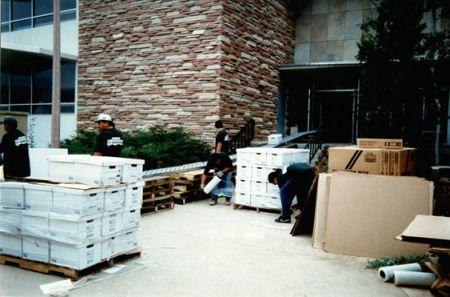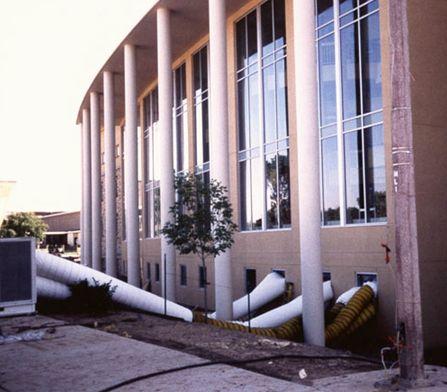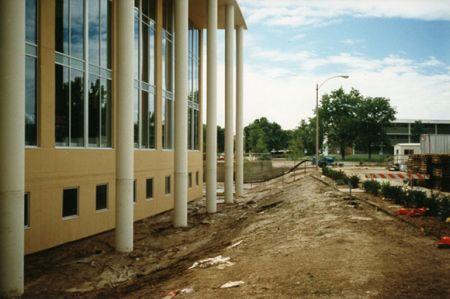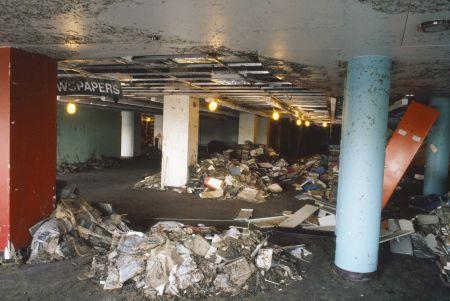Spring Creek Flood of 1997
Full Article
On July 28, 1997, the city of Fort Collins was inundated with the heaviest rains ever recorded in a Colorado urban area. During the peak of the storm, about six inches fell in an hour and a half. This caused Spring Creek, a tributary of the Cache la Poudre River, to rise thirty feet beyond its banks and flood nearby areas, including the Colorado State University campus and western Fort Collins. In the months following the disaster, Fort Collins spent about $5 million on recovery and improving its flood warning system.
Fort Collins Geography and Settlement
Fort Collins, a city with a population of nearly 108,000 in July of 1997, is nestled against the foothills of the Rocky Mountains along the Interstate 25 corridor. The region is considered semiarid, a climate characterized by light annual rainfall, which undoubtedly lulled some residents into complacency regarding the threat of floods. Fort Collins’ major river is the Cache la Poudre, which runs east from Rocky Mountain National Park through the city, across the plains, and into the South Platte River.
The founders of the Camp Collins military post in 1862 did not possess enough knowledge about the Poudre River and the surrounding geography to anticipate the consequences of locating their community near the floodplain. Just two years later, the Cache la Poudre River overflowed, destroying cabins, tents, and ammunition. Although no lives were lost, the flooding devastated the camp, and the soldiers living in the area recognized the necessity to move their operations to higher ground. Three months later, the settlement was relocated slightly north and officially renamed Fort Collins. Over the next century and a half, the area would experience eleven significant floods. As the city’s population grew, parking lots, roads, and other impermeable surfaces replaced the rock, dirt, and vegetation, limiting the landscape’s ability to absorb runoff.
Spring Creek Overflows
During the summer of 1997, Fort Collins had experienced a six-week period of hot and dry weather. On July 27, the first rainfall came. Over the next thirty hours, an estimated 10 to 14.5 inches of rain fell across the city, causing Spring Creek to overflow, washing out homes, damaging infrastructure, and claiming multiple lives. Steve Fleming, captain of the Poudre Fire Authority, was one of the first responders to the flood. Fleming told the Fort Collins Coloradoan, “We had campers and propane cylinders; there was a trailer on fire, explosions at the laundromat, train derailment, people yelling for help, oil in the water, electricity shocking me in houses, water up within one foot of the ceilings, and all of it happened within 30 minutes.” The flood killed five people. Four of the fatalities happened in a mobile home park on College Avenue just south of Prospect Road, and the fifth occurred in a residential area just downstream. In addition to the deaths, the flood caused over $200 million in property damage, destroyed 200 homes, and injured 54 people.
At Moby Arena on the west side of campus, 3,500 high school students attending a spiritual program had intended to move to the Lory Student Center for activities that evening. The program at Moby, however, lasted longer than expected and did not finish until after the serious flooding had started. At about 10 pm, while the students were still at Moby, the basement of the Lory Student Center quickly filled with water. Had the students not been held up in Moby Arena, the storm could have produced hundreds of fatalities instead of five.
The flood also had a dramatic effect on the rest of the Colorado State University campus. More than forty buildings were damaged, many of which housed employee offices and classrooms containing personal and professional belongings. In several cases a lifetime of research materials were lost. At the library, about 425,000 books stored in the basement for a summer renovation project were damaged. The total fiscal damage to the campus surpassed $100 million. Despite the devastation to the campus in late summer, the university community pulled together and started the new semester—on time—in August.
Response to the Flood
Fort Collins, having experienced many floods during the past century, had put various safeguards in place to lessen their effects in the future. After the Spring Creek Flood of 1997, additional improvements were made. New infrastructure—including channels, floodwater retention basins, and retaining walls—were installed. The city also implemented a flood warning system funded by the Federal Emergency Management Agency (FEMA). This system, which includes a series of rainfall gauges, provides information to FEMA, which can then help guide community responses before, during, and after a flash flood. By 1999, the city and university had improved flood awareness and communication with the implementation of both a warning system and a community weather-watching program. This program, called the Community Collaborative Rain, Hail and Snow Network (CoCoRaHS), was developed by the Colorado Climate Center at CSU a year after the flood and facilitates quick communication during disasters. It has since been replicated nationally.
The Spring Creek Flood of 1997 was the most significant natural disaster to ever strike the Fort Collins community. A sudden downpour and a lack of preparation led to millions of dollars in damage and lost lives. The city of Fort Collins used this experience to better prepare for future floods.






















